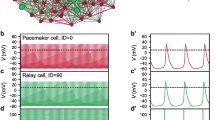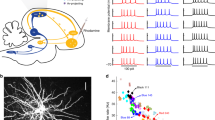Abstract
With the goal of building a model of the HVC nucleus in the avian song system, we discuss in detail a model of HVC\(_{\mathrm{RA}}\) projection neurons comprised of a somatic compartment with fast Na\(^+\) and K\(^+\) currents and a dendritic compartment with slower Ca\(^{2+}\) dynamics. We show this model qualitatively exhibits many observed electrophysiological behaviors. We then show in numerical procedures how one can design and analyze feasible laboratory experiments that allow the estimation of all of the many parameters and unmeasured dynamical variables, given observations of the somatic voltage \(V_\mathrm{s}(t)\) alone. A key to this procedure is to initially estimate the slow dynamics associated with Ca, blocking the fast Na and K variations, and then with the Ca parameters fixed estimate the fast Na and K dynamics. This separation of time scales provides a numerically robust method for completing the full neuron model, and the efficacy of the method is tested by prediction when observations are complete. The simulation provides a framework for the slice preparation experiments and illustrates the use of data assimilation methods for the design of those experiments.














Similar content being viewed by others
References
Sterratt D, Graham B, Gillies A, Willshaw D (2011) Principles of computational modeling in neuroscience. Cambridge University Press, Cambridge
Johnston D, Wu SMS (1995) Foundations of cellular neurophysiology. MIT Press, Cambridge
Hahnloser RHR, Kozhevnikov AA, Fee MS (2002) An ultra-sparse code underlies the generation of neural sequences in a songbird. Nature 419(6902):65 (Erratum)
Konishi M (1985) Birdsong: from behavior to neuron. Ann Rev Neurosci 8(1):125
Abarbanel HDI (2013) Predicting the future: completing models of observed complex systems. Springer, New York
Toth BA, Kostuk M, Meliza CD, Margoliash D, Abarbanel HDI (2011) Dynamical estimation of neuron and network properties I: variational methods. Biol Cybern 105(3–4):217
Kostuk M, Toth BA, Meliza CD, Margoliash D, Abarbanel HDI (2012) Dynamical estimation of neuron and network properties II: path integral Monte Carlo methods. Biol Cybern 106(3):155
Meliza CD, Kostuk M, Huang H, Nogaret A, Margoliash D, Abarbanel HD (2014) Estimating parameters and predicting membrane voltages with conductance-based neuron models. Biol Cybern 108(4):495
Abarbanel HDI, Bryant P, Gill PE, Kostuk M, Rofeh J, Singer Z, Toth B, Wong E (2011) Dynamical parameter and state estimation in neuron models. In: Ding M, Glanzman DL (eds) The dynamic brain: an exploration of neuronal variability and its functional significance. Oxford University Press, New York
Ye J, Rozdeba PJ, Morone UI, Daou A, Abarbanel HD (2014) Estimating the biophysical properties of neurons with intracellular calcium dynamics. Phys Rev E 89(6):062714
Rey D, Eldridge M, Kostuk M, Abarbanel HDI, Schumann-Bischoff J, Parlitz U (2014) Accurate state and parameter estimation in nonlinear systems with sparse observations. Phys Lett A 378(11):869
Ye J, Kadakia N, Rozdeba PJ, Abarbanel HDI, Quinn JC (2015) Improved variational methods in statistical data assimilation. Nonlinear Process Geophys 22:205
Ye J, Rey D, Kadakia N, Eldridge M, Morone UI, Rozdeba PJ, Abarbanel HDI, Quinn JC (2015) Systematic variational method for statistical nonlinear state and parameter estimation. Phys Rev E 92(12):052901
Vanier MC, Bower JM (1999) A comparative survey of automated parameter-search methods for compartmental neural models. J Comput Neurosci 7(2):149
Keren N, Peled N, Korngreen A (2005) Constraining compartmental models using multiple voltage recordings and genetic algorithms. J Neurophysiol 94(6):3730
Buhry L, Pace M, Saïghi S (2012) Global parameter estimation of an Hodgkin Huxley formalism using membrane voltage recordings: application to neuro-mimetic analog integrated circuits. Neurocomputing 81:75
Gibb L, Gentner TQ, Abarbanel HDI (2009) Inhibition and recurrent excitation in a computational model of sparse bursting in song nucleus HVC. J Neurophysiol 102:1748
Kosche G, Vallentin D, Long MA (2015) Interplay of inhibition and excitation shapes a premotor neural sequence. J Neurosci 35(3):1217
Dayan P, Abbott LF (2005) Theoretical neuroscience: computational and mathematical modeling of neural systems. MIT Press, Cambridge, Massachusetts
Ermentrout GB, Terman DH (2010) Interdisciplinary applied mathematics. In: Mathematical foundations of neuroscience. Springer
Izhikevich EM (2007) Dynamical systems in neuroscience: the geometry of excitability and bursting. Comput Neurosci. MIT Press, Cambridge
Fee MS, Kozhevnikov AA, Hahnloser RHR (2004) Neural mechanisms of vocal sequence generation in the songbird. Ann N Y Acad Sci 1016:153–170
Jin DZ, Ramazanoglu FM, Seung HS (2007) Neural mechanisms of vocal sequence generation in the songbird. J Comput Neurosci 23(3):283
Long MA, Jin DZ, Fee MS (2010) Support for a synaptic chain model of neuronal sequence generation. Nature 48(7322):394
Daou A, Ross MT, Johnson F, Hyson RL, Bertram R (2013) Electrophysiological characterization and computational models of HVC neurons in the zebra finch. J Neurophysiol 110(5):1227
Kubota M, Taniguchi I (1998) Electrophysiological characteristics of classes of neuron in the HVc of the zebra finch. J Neurophysiol 80(2):914
Mooney R, Prather JF (2005) The HVC microcircuit: the synaptic basis for interactions between song motor and vocal plasticity pathways. J Neurosci 25(8):1952
Kandel ER, Schwartz JH, Jessell TM (eds) (2000) Principles of neural science, 4th edn. McGraw-Hill, New York
Laplace, P (1774) Memoir on the probability of causes of events. Mémoires de Mathématique et de Physique Tome Sixième
Zinn-Justin J (2002) Quantum field theory and critical phenomena. Oxford University Press, Oxford
Wächter A, Biegler LT (2006) On the implementation of an interior-point filter line-search algorithm for large-scale nonlinear programming. Math Progr 106(1):25
Graber MH, Helmchen F, Hahnloser RHR (2013) Activity in a premotor cortical nucleus of zebra finches is locally organized and exhibits auditory selectivity in neurons but not in glia PLoS ONE 8(12):1
Peh W, Roberts T, Mooney R (2015) Imaging auditory representations of song and syllables in populations of sensorimotor neurons essential to vocal communication. J Neurosci 35:5589
Author information
Authors and Affiliations
Corresponding author
Rights and permissions
About this article
Cite this article
Kadakia, N., Armstrong, E., Breen, D. et al. Nonlinear statistical data assimilation for HVC\(_{\mathrm{RA}}\) neurons in the avian song system. Biol Cybern 110, 417–434 (2016). https://doi.org/10.1007/s00422-016-0697-3
Received:
Accepted:
Published:
Issue Date:
DOI: https://doi.org/10.1007/s00422-016-0697-3




